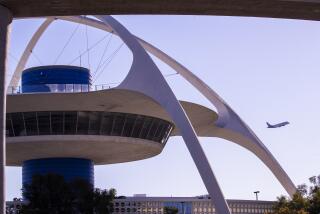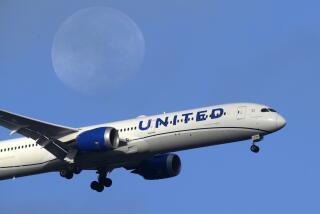FAA Staff Blindsided by Attacks
WASHINGTON — The first person in the government to realize that something had gone awfully wrong on Sept. 11, 2001, was Pete Zalewski, an air traffic controller at his radar screen in a darkened, windowless room in a Federal Aviation Administration facility in Nashua, N.H.
For 10 minutes or so, Zalewski had been trying to figure out why American Airlines Flight 11 from Boston to Los Angeles had stopped responding to his radio calls and why an automatic identification signal sent by the plane had suddenly vanished from his screen.
He suspected a mechanical problem. But then a radio transmission from the cockpit of the Boeing 767 came over his headset.
“We have some planes. Just stay quiet, and you’ll be OK. We are returning to the airport.” A few seconds later, at 8:24 a.m., the unfamiliar voice spoke again: “Nobody move. Everything will be OK. If you try to make any moves, you’ll endanger yourself and the airplane.”
The speaker may have been using the plane’s public address system and was probably unaware his words were also being transmitted to the ground.
Zalewski immediately notified his supervisor that he believed Flight 11 had been hijacked. But in the strangeness and suddenness of that moment, he did not initially decipher perhaps the most important clue: The hijacker had spoken of “planes.” Transcripts of the radio transmissions were released Thursday in a report by the staff of the Sept. 11 commission.
In the transcripts, the efforts of controllers in New England and New York to figure out what was happening and react quickly highlighted the weaknesses of procedures then in place and the strengths of individuals working in the system.
Communications among government personnel and agencies were fragmented, confused and slow, the commission’s staff report found.
But individuals at the FAA’s Boston Center in New Hampshire and its New York Center on Long Island also seized the initiative when they could.
Boston Center called for military planes directly instead of going through the FAA’s Washington headquarters, which would have taken longer. It also stopped all departures, and New York declared its airspace off-limits to all planes.
Since the attacks, much has been changed.
Coordination with the military has improved. An airliner that stopped responding to radio calls and transmitting its identification code and course now would be intercepted by fighters.
Cockpit doors have been hardened to resist heavy pounding and even bullets. And controllers are keenly aware that what may seem like an equipment glitch can turn out to be an attack.
But the report shows that determined would-be hijackers could exploit a system that never envisioned suicide attackers using commercial jetliners as terrorist missiles.
Zalewski hadn’t imagined such a thing either. He and other controllers were not identified by name in the report to the commission. However, he and others have come forward, speaking on the record a year after the attacks in interviews on NBC’s “Dateline” program.
Because Zalewski wasn’t sure he had fully understood the radio transmission, his manager asked somebody else to listen to the tape.
“It was just a foreign voice,” Zalewski told NBC. “It was something very different. To me, it sounded almost Middle Eastern.” He could not be reached Thursday.
By 8:25 a.m., the FAA’s Boston Center had begun notifying the chain of command that American Flight 11 had been hijacked. Though the plane had stopped signaling its course, controllers were able to track it using a backup radar system.
Then came another radio transmission from the hijacker, at 8:34. “Don’t try to make any stupid moves,” the voice said. Boston Center immediately started trying to reach the military. About 8:38, the FAA managers got through to the North American Aerospace Defense Command, or NORAD.
“Is this real-world or exercise?” the air defense command responded. Fighter jets were scrambled, but Flight 11 was bearing down on its target.
The airliner was now being tracked by New York Center on Long Island, near the Islip airport. Such centers handle aircraft en route to their destinations in high-altitude flight.
Controller Dave Bottiglia was intently focused on Flight 11 when it disappeared from his screen just before 8:47. It had plowed into the World Trade Center’s north tower, but that wasn’t immediately evident to the controllers. The commission staff report said they kept trying to locate the plane on radar.
Suddenly, Bottiglia realized another of his planes might be in trouble. United Flight 175, a Boeing 767 scheduled to fly from Boston to Los Angeles, had changed its transponder code, which consisted of its identification and locator. It was 8:51.
The commission found that the transponder changes had actually begun about four minutes earlier. “These changes were not noticed for several minutes because the controller was focused on finding American 11, which had disappeared,” the commission report said.
United Flight 175 did not respond to repeated radio calls from Bottiglia, and he quickly alerted other controllers that a second hijacking might be underway.
At about 8:55, Bottiglia’s supervisor told a senior New York manager that United Flight 175 might also have been hijacked. The manager tried to pass the word to regional higher-ups but was told they were having a meeting about Flight 11’s hijacking and could not be disturbed, the commission report found.
Just after 9 a.m., a manager from New York got through to the FAA’s national operations center in Herndon, Va., near Washington Dulles International Airport.
“We have several situations going on here,” the New York manager said. “It’s escalating big, big time. We need to get the military involved.”
That was the only notice FAA headquarters received of a second hijacking before United Flight 175 struck the World Trade Center’s south tower at 9:03.
The two other hijacked planes were already in the air. American Flight 77 from Dulles to Los Angeles would hit the Pentagon at 9:37. United Flight 93 from Newark to San Francisco would crash in Pennsylvania shortly after 10 a.m., apparently after passengers tried to take back the cockpit from the hijackers.
Meanwhile, Boston Center called regional supervisors in New England to report that what Zalewski had heard on the radio from Flight 11 had just been deciphered.
“The guy said that ‘we have planes,’ ” Boston Center reported.
“They have what?” asked an unidentified participant in the teleconference.
“Planes, as in plural,” Boston Center responded.
More to Read
Sign up for Essential California
The most important California stories and recommendations in your inbox every morning.
You may occasionally receive promotional content from the Los Angeles Times.










